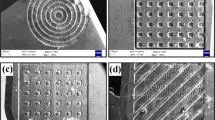Abstract
Thermally sprayed coatings offer a promising approach as efficient method to increase the wear-resistance of sheet metal forming tools. However, the roughness of thermally sprayed surfaces is quite high. The use of these coatings for deep drawing tools results in poor sheet surface qualities and low drawing ratios. Because it is suspected that high friction is the reason for the low drawability, hard metal coatings (WC–12Co), deposited by high velocity oxygen fuel flame-spraying, were machined by grinding and ball burnishing to improve their friction behavior and the accuracy of the tool shape. The investigation was conducted by plane strip drawing tests. Strips of high strength steel were mated with these novel and effective coatings at different normal contact pressures and drawing velocities. Uncoated friction elements made of C60 steel were considered as reference during the analysis. The results revealed that coated but unmachined friction elements showed high friction values, which led to scratch marks on the sheet surface after drawing. Applying the finishing processes, the friction coefficient could be reduced significantly. Additionally, deep drawing tests were carried out to determine the drawing ratio for coated, unmachined as well as for processed, coated dies. Thermally sprayed and ball burnished as well as thermally sprayed and ground coatings are feasible for deep drawing. Due to the post treatment, the drawing ratio β = 1.8 was increased to 2.0. This is consistent to the results of the friction tests.
















Similar content being viewed by others
References
Kleiner M, Geiger M, Klaus A (2003) Manufacturing of lightweight components by metal forming. Ann CIRP 52(2):521–542
Doege E, Dröder K (1997) Einsatz von keramik als werkzeugwerkstoff in der blechumformung. Umformen Hochfester Stähle, Bänder Bleche Rohre 38(12):16–21
Tillmann W, Vogli E, Baumann I, Krebs B, Nebel J (2010) Wear-protective cermet coatings for forming tools. Mat-wiss u Werkstofftech 41(7):597–607
Doege E, Behrens BA (2007) Handbuch umformtechnik. Springer, Berlin
Vollertsen F, Hu Z (2008) Determination of size-dependent friction functions in sheet metal forming with respect to the distribution of the contact pressure. Prod Eng Res Dev 2(4):345–350
Wagner S (1996) 3D-Beschreibung der oberflächenstrukturen von feinblechen. Dissertation TU Stuttgart
Emmens WC (1997) Tribology of flat contact. Phd-Thesis University of Twenty
Emmens WC (1988) The influence of surface roughness on friction. In: proceedings of the 15th IDDRG congress. Dearborn, MI, USA, pp 63–70
Wanheim T, Bay N, Petersen AS (1974) A theoretically determined model for friction in metal working processes. Wear 28:251–258
Franzen V, Witulski J, Brosius A, Trompeter M, Tekkaya AE (2011) Thermally sprayed coatings as effective tool surfaces in sheet metal forming applications. J Therm Spray Technol 20(4):939–947
Edinger M (1997) Untersuchung zur spanenden endbearbeitung und zum funktionsverhalten von thermisch gespritzten verschleißschutzschichten. Dissertation Universität Kaiserslautern
Packeisen A (2000) Material aspects of grinding wear resistant alloys. Fortschr-Ber VDI Reihe 5/610
Rausch S, Biermann D (2012) Grinding of hard-material-coated forming tools on machining centers. In: Proceedings of the 5th CIRP int conf on high performance cutting, pp 388–392
Massad RB (1985) Thermal spray coatings—superabrasives for ease of finishing. In: Superabrasives’85. In: Proceedings of a symposium sponsored by Diamond Wheel Manuf Inst, Ind Diamond Ass of Amer and SME, pp 6–14
Klocke F, Linke B (2008) Mechanisms in the generation of grinding wheel topography by dressing. Prod Eng Res Dev 2(2):157–163
Zhang B, Liu X, Brown CA, Bergstrom TS (2002) Microgrinding of nanostructured material coatings. Ann CIRP 51(1):251–254
Denkena B, Köhler J, Kästner J (2012) Chip formation in grinding: an experimental study. In: proceedings of Eng Res Devel 6(2):107–115
Murthy JKN, Rao DS, Venkataraman B (2001) Effect of grinding on the erosion behavior of a WC-Co-Cr coating deposited by HVOF and detonation gun spray processes. Wear 249(7):592–600
Biermann D, Mohn T, Blum H, Kleemann H (2010) Grinding of arc-sprayed tungsten carbide coatings on machining centers. Process configuration and simulation. Key Eng Mater 438:115–122
Lange K (1990) Lehrbuch der umformtechnik band 3: blechbearbeitung. Springer, Berlin
Steinhoff K, Rasp W, Pawelski O (1996) Development of deterministic-stochastic surface structures to improve the tribological conditions of sheet forming processes. J Mat Proc Tech 60:355–361
Pettersson U, Jacobson S (2004) Friction and wear properties of micro textured DLC coated surfaces in boundary lubricated sliding. Tribol Lett 17(3):553–559
Acknowledgments
This work within the scope of subprojects A3 and A5 of the Collaborative Research Center (SFB708) “3D-Surface Engineering of Tools for Sheet Metal Forming—Manufacturing, Modeling, Machining” is kindly supported by the German Research Foundation (DFG), the central public funding organization for academic research in Germany. The authors would also like to thank Peter Hollingsworth from the Chair of Materials Engineering of TU Dortmund University, Germany, for preparing the thermally sprayed coatings.
Author information
Authors and Affiliations
Corresponding authors
Rights and permissions
About this article
Cite this article
Tekkaya, A.E., Kleiner, M., Biermann, D. et al. Friction analysis of thermally sprayed coatings finished by ball burnishing and grinding. Prod. Eng. Res. Devel. 7, 601–610 (2013). https://doi.org/10.1007/s11740-013-0485-z
Received:
Accepted:
Published:
Issue Date:
DOI: https://doi.org/10.1007/s11740-013-0485-z




